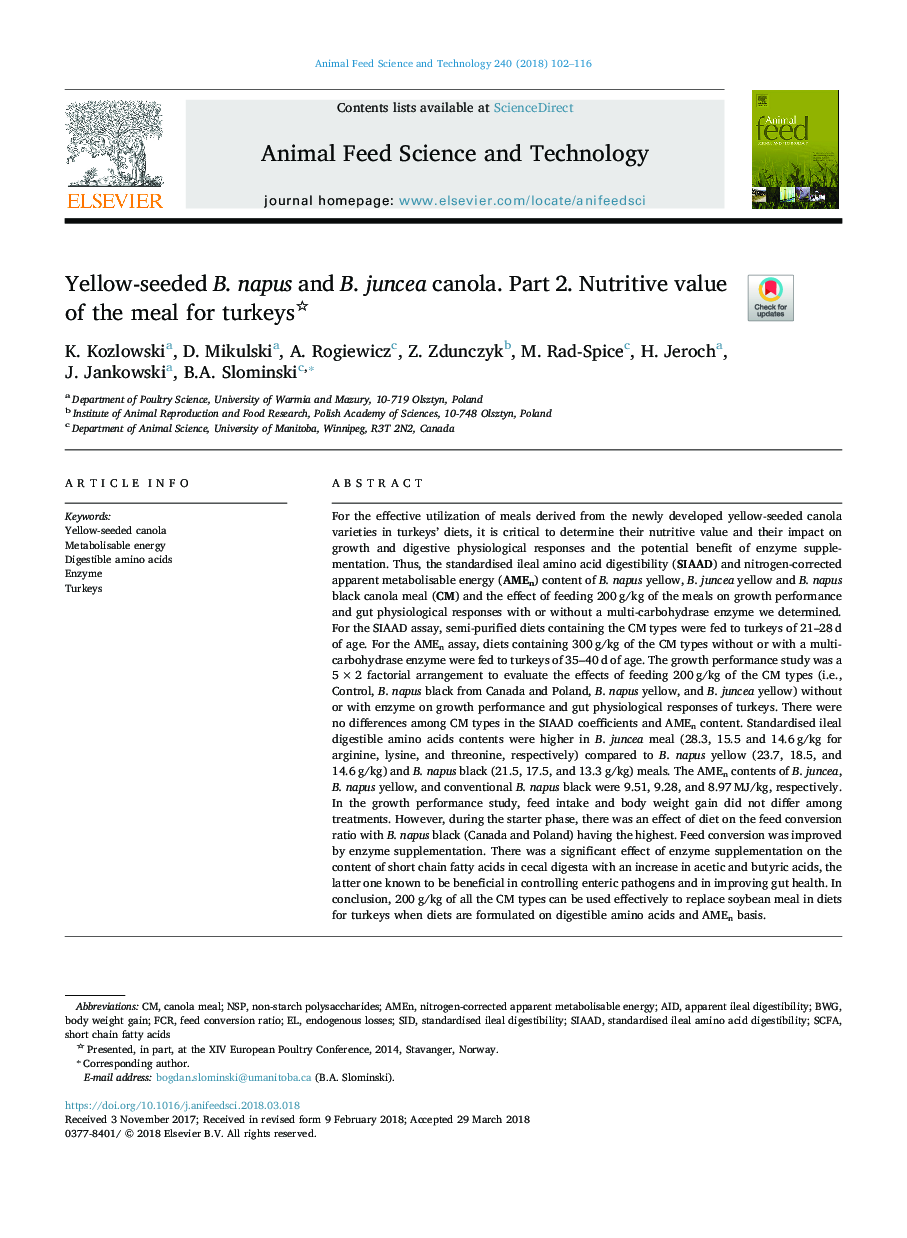| کد مقاله | کد نشریه | سال انتشار | مقاله انگلیسی | نسخه تمام متن |
|---|---|---|---|---|
| 8490963 | 1552346 | 2018 | 15 صفحه PDF | دانلود رایگان |
عنوان انگلیسی مقاله ISI
Yellow-seeded B. napus and B. juncea canola. Part 2. Nutritive value of the meal for turkeys
ترجمه فارسی عنوان
زردآلو بذر ناپوس و بوته یونسا کانولا. قسمت 2. ارزش تغذیه ای از غذا برای بوقلمون
دانلود مقاله + سفارش ترجمه
دانلود مقاله ISI انگلیسی
رایگان برای ایرانیان
کلمات کلیدی
SCFANSPFCRDigestible amino acidsStandardised ileal digestibilityAMEnBWGEnzyme - آنزیم یا کاتالیزگرShort chain fatty acids - اسیدهای چرب پایه کوتاهBody weight gain - افزایش وزن بدنmetabolisable energy - انرژی قابل متابولیسمnitrogen-corrected apparent metabolisable energy - انرژی قابل متابولیسم آشکار شده توسط نیتروژنTurkeys - بوقلمونEndogenous losses - تلفات اندوژنSiD - سی دیCanola meal - غذای کانولاfeed conversion ratio - نسبت تبدیل خوراکApparent ileal digestibility - هضم ظاهری ایلئالnon-starch polysaccharides - پلی ساکارید غیر نشاستهAID - کمک
موضوعات مرتبط
علوم زیستی و بیوفناوری
علوم کشاورزی و بیولوژیک
علوم دامی و جانورشناسی
چکیده انگلیسی
For the effective utilization of meals derived from the newly developed yellow-seeded canola varieties in turkeys' diets, it is critical to determine their nutritive value and their impact on growth and digestive physiological responses and the potential benefit of enzyme supplementation. Thus, the standardised ileal amino acid digestibility (SIAAD) and nitrogen-corrected apparent metabolisable energy (AMEn) content of B. napus yellow, B. juncea yellow and B. napus black canola meal (CM) and the effect of feeding 200â¯g/kg of the meals on growth performance and gut physiological responses with or without a multi-carbohydrase enzyme we determined. For the SIAAD assay, semi-purified diets containing the CM types were fed to turkeys of 21-28â¯d of age. For the AMEn assay, diets containing 300â¯g/kg of the CM types without or with a multi-carbohydrase enzyme were fed to turkeys of 35-40â¯d of age. The growth performance study was a 5â¯Ãâ¯2 factorial arrangement to evaluate the effects of feeding 200â¯g/kg of the CM types (i.e., Control, B. napus black from Canada and Poland, B. napus yellow, and B. juncea yellow) without or with enzyme on growth performance and gut physiological responses of turkeys. There were no differences among CM types in the SIAAD coefficients and AMEn content. Standardised ileal digestible amino acids contents were higher in B. juncea meal (28.3, 15.5 and 14.6â¯g/kg for arginine, lysine, and threonine, respectively) compared to B. napus yellow (23.7, 18.5, and 14.6â¯g/kg) and B. napus black (21.5, 17.5, and 13.3â¯g/kg) meals. The AMEn contents of B. juncea, B. napus yellow, and conventional B. napus black were 9.51, 9.28, and 8.97â¯MJ/kg, respectively. In the growth performance study, feed intake and body weight gain did not differ among treatments. However, during the starter phase, there was an effect of diet on the feed conversion ratio with B. napus black (Canada and Poland) having the highest. Feed conversion was improved by enzyme supplementation. There was a significant effect of enzyme supplementation on the content of short chain fatty acids in cecal digesta with an increase in acetic and butyric acids, the latter one known to be beneficial in controlling enteric pathogens and in improving gut health. In conclusion, 200â¯g/kg of all the CM types can be used effectively to replace soybean meal in diets for turkeys when diets are formulated on digestible amino acids and AMEn basis.
ناشر
Database: Elsevier - ScienceDirect (ساینس دایرکت)
Journal: Animal Feed Science and Technology - Volume 240, June 2018, Pages 102-116
Journal: Animal Feed Science and Technology - Volume 240, June 2018, Pages 102-116
نویسندگان
K. Kozlowski, D. Mikulski, A. Rogiewicz, Z. Zdunczyk, M. Rad-Spice, H. Jeroch, J. Jankowski, B.A. Slominski,
